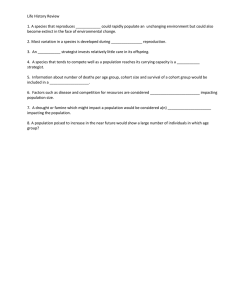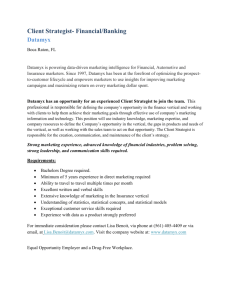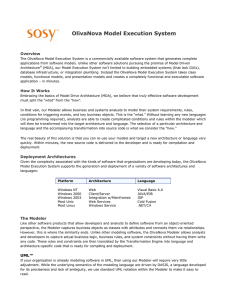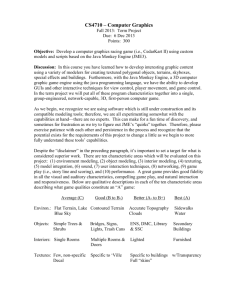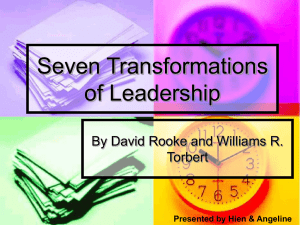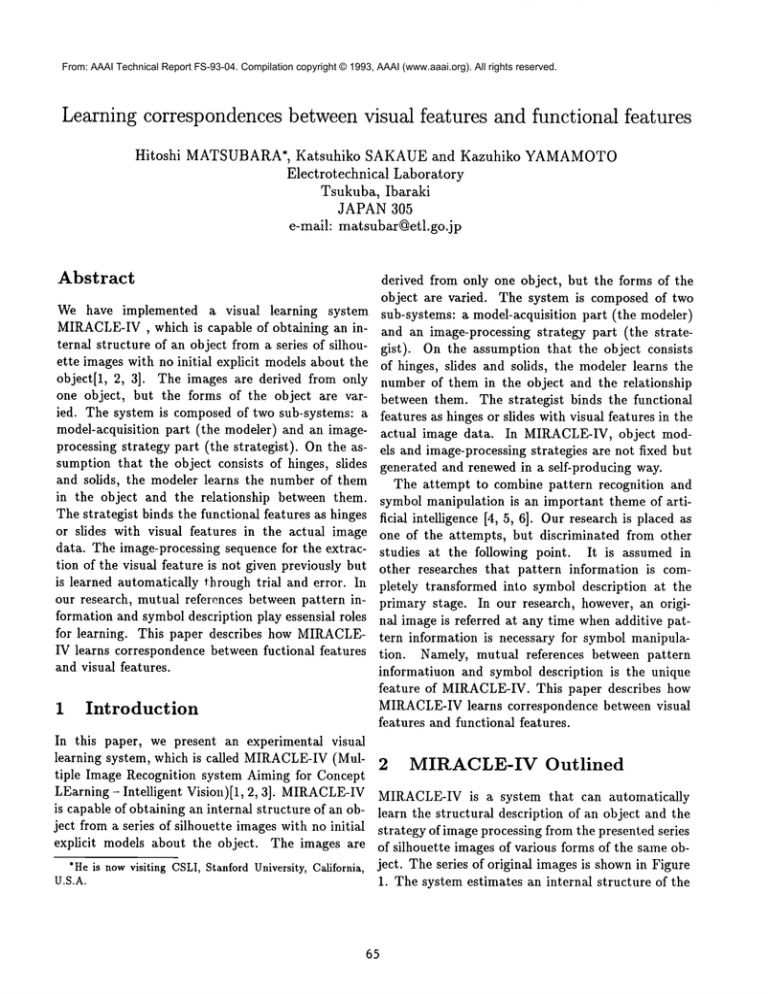
From: AAAI Technical Report FS-93-04. Compilation copyright © 1993, AAAI (www.aaai.org). All rights reserved.
Learning correspondences between visual features and functional features
Hitoshi
MATSUBARA*, Katsuhiko
SAKAUE and Kazuhiko
Electrotechnical
Laboratory
Tsukuba, Ibaraki
JAPAN 3O5
e-mail: matsubar@etl.go.jp
YAMAMOTO
Abstract
derived from only one object, but the forms of the
object are varied. The system is composed of two
We have implemented a visual learning system sub-systems: a model-acquisition part (the modeler)
MIRACLE-IV
, which is capable of obtaining an in- and an image-processing strategy part (the strateternai structure of an object from a series of silhou- gist). On the assumption that the object consists
ette images with no initial explicit models about the of hinges, slides and solids, the modeler learns the
object[l, 2, 3]. The images are derived from only number of them in the object and the relationship
one object, but the forms of the object are var- between them. The strategist
binds the functional
ied. The system is composed of two sub-systems: a features as hinges or slides with visual features in the
model-acquisition part (the modeler) and an image- actual image data. In MIRACLE-IV,object modprocessing strategy part (the strategist). On the as- els and image-processing strategies are not fixed but
sumption that the object consists of hinges, slides generated and renewed in a self-producing way.
and solids, the modeler learns the number of them
The attempt to combine pattern recognition and
in the object and the relationship between them. symbol manipulation is an important theme of artiThe strategist binds the functional features as hinges ficiM intelligence [4, 5, 6]. Our research is placed as
or slides with visual features in the actual image one of the attempts, but discriminated from other
data. The image-processing sequence for the extrac- studies at the following point. It is assumed in
tion of the visual feature is not given previously but other researches that pattern information is comis learned automatically through trial and error. In pletely transformed into symbol description at the
our research, mutual references between pattern in- primary stage. In our research, however, an origiformation and symbol description play essensial roles nal image is referred at any time whenadditive patfor learning. This paper describes how MIRACLE- tern information is necessary for symbol manipulaIV learns correspondence between fuctional features tion. Namely, mutual references between pattern
and visual features.
informatiuon and symbol description is the unique
feature of MIRACLE-IV.This paper describes how
MIRACLE-IV
learns correspondence between visual
1 Introduction
features and functional features.
In this paper, we present an experimental visual
learning system, which is called MIRACLE-IV
(Mul2 MIRACLE-IV Outlined
tiple Image Recognition system Aiming for Concept
LEarning- Intelligent Vision)[1, 2, 3]. MIRACLE-IVMIRACLE-IVis a system that can automatically
is capable of obtaining an internal structure of an ob- learn the structural description of an object and the
ject from a series of silhouette images with no initial
strategy of imageprocessing from the presented series
explicit models about the object. The images are of silhouette images of various forms of the same ob*Heis nowvisiting CSLI,StanfordUniversity,California, ject. The series of original images is shownin Figure
U.S.A.
1. The system estimates an internal structure of the
65
The modeler knows beforehand that an object consists of hinges, slides and solids and that variations
of the form are two-dimensional. It learns afterwards
the numberof hinges, slides and solids and their mutual relations. On the other hand, the strategist
knows beforehand only physical constraints on the
connection amongindividual processing modules. It
accumulates afterwards strategic knowledgeof imageprocessing sequences in the computer by organizing
successful examples that have happened to be obtained through trial and error.
As mentioned above, knowledge of the modeler
Figure 1: A series of original images
is explicitly separated from that of the strategist,
and vice versa. The modeler knows nothing about
image-processing modules, and the strategist knows
nothing about internal structures. The learning process of MIRACLE-IV
is done through the interacvisual feature
tion between the modeler and the strategist.
Such
a two-subsystem-organization
of MIRACLE-IV
contributes to generality of the system because the
"BELIEF"
physical
strategic knowledgeaccumulated in the strategist is
a kind of
law
independent of a structure of a specific object. While
analogy
the modeler manipulates the symbol description, the
strategist processes the pattern information, and, if
necessary, they exchange their information properly.
HINGE
functional
feature
In MIRACLE-IV,
applying actual image data to conFigure 2: Corrspondence between the visual feature cept learning has an essenatial meaning.
and the functional feature
The mechanism of the modeler depends strongly
on what kind of objects MIRACLE-IV
accepts. The
accepts are simple tools and
object from the variety of the form on the silhouette objects MIRACLE-IV
implements
such
as
compasses,
scissors and rulers.
images and constructs a:, appropriate model. Furthermore, it is attempted to make a correspondence Pratical tools are generally easy to makecorresponbetween the internal structure and the visual features dence between their visual features and their func(See Figure 2). This means that a kind of analogy tional features because there are no useless decorations on them.
("belief’) , such that if one resembles the other in
visual feature, their functions are also similar, is established on the computer. This belief is utilized to 3
The Modeler
estimate the internal structure effectively. An image
processing sequence for the extraction of the visual Wehave selected a pair of compasses as an example
feature is not given previously and is learned auto- object. By handling it with our hands, we can change
matically through trial and error.
its form in various ways. We let MIRACLE-IV
see
The system is composed of two sub-systems: a somesilhouette images of the various forms in an ormodel-acquisition part (the modeler) and an image- der. The order, which is important to learning, will
processing strategy part (the strategist) . The for- be discussed later in this section. Wetell MIRACLEmer estimates an internal structure of the object and IV that all the images are derived from only one obextracts a functional feature. The latter binds the ject, "compasses", but do not tell what compasses
internal structure with the visual feature of actual are. So MIRACLE-IVdoes not have any explicit
image data.
models of compasses initially.
Under such circum-
56
stances, the modeler acquires the internal structure
of the object through the interaction with the strategist. The acquired model consists of the knowledge
about the number of the hinges in the object and the
relation between the hinges and so on.
It is often said that learning something new requires a lot of previous knowledge about the thing.
In machine learning, a dividing line between the already known and the newly learned should be set
appropriately. It is very difficult for the computerto
learn an internal structure of the object whose form
changes freely. So we have to restrict the degree of
freedom of changes. We assume that the change is
caused by only hinges and slides. Namely, it is assumed that the modeler knows that the object consists of three constituents: hinge, slide and solid. We
call this knowledge HSS assumption. On the HSS
assumption, the modeler learns from a series of silhouette images howmanyhinges, slides or solids the
object has and how they are connected.
Besides the HSSasumption, the modeler utilizes
the following heuristics.
¯ The numberof solids in the object is small.
¯ The frequency of hinges is higher than that of
slides.
¯ The variations of the form are two-dimentional.
The order of input images must be determined
carefully by man for incremental learning. A form
whichis slightly different than the form that has been
input just before must be input one by one. To put
it concretely, a form which is different in only one
position of a hinge or a slide than the form input
just before will be input. If we input a form which
is different in more than two positions, the learning
process of the modeler does not work well in general.
The modeler receives a shape description, such as a
set of line segments, from the strategist. The modeler
has to decide the correspondence between one set of
line segments and the other. As form and direction
of the object are varied under the HSSassumption, a
flexible matching methodis required for the modeler.
Weadopt an extended relaxation method to make
the constraint between adjacent line segments propagated. This is an extension of the relaxation method
for the recognition of hand-printed KANJI(Chinese)
67
characters[7]. In the correspondence process, the
modelerinfers locations of hinges or slides. The inference is based on the information about two kinds of
relaxation parameters: angle and length. In essence,
the modeler imagines the existence of a hinge by the
difference of angles, and the existence of a slide by
the difference of lengths.
Wehave not analysed the capability of the extended relaxation methodquantitatively, but it works
well in most cases under the above conditions.
4
The Strategist
The aim of the strategist is to bind the functional
features of the object which are obtained by the
modeler with the visual features in the raw image
data. The automatic trial-and-error
process of the
strategist makes it possible to generate an appropriate image-processing sequence, which consists of
various kinds of image processing modules (such as
binarization module, boundary extraction module).
Some rule-based systems also have an automatic
triM-and-error function to get to a goal. Their
knowledge-basesto control the process should be constructed and tuned beforehand. In our strategist,
however, only given are data-type constraint rules
for the connection of processing modules. It can construct a strategic database through the accumulation
and systematization of fortunate success examples in
manytrials.
A hinge which is a typical functional feature of
compasses often has a circular shape. In the initial
stage, however, the strategist knows nothing about
visual features of a hinge. In this case, the modeler
estimates existence possibility and predicted location
of the hinge from the given silhouette images, and
requests the strategist to detect the hinge by means
of visual features. The strategist repeats the trim and
error of image processing until the predicted location
is detected as a visual feature; success will cause it
to learn an image processing strategy corresponding
to the hinge.
The correspondence between functional and visual
features is independent of the kind of an object;
we can see circular hinges in many tools or implements. If reliable strategies are sufficiently acquired,
the strategist will be able to infer an internal struc-
1. The first set of line segments (see Figure 3(1))
given by the strategist is kept as an initial structural description
of the object. No structural
information is gained by only one image, so the
modeler does nothing particular.
The modeler
knows that hinges can be bent, but does not
know that bent parts can be hinges. The model
of "compasses" at the time consisits of one solid.
/
I
bl / b2
SOLID-A1 = (al
r
.~t
z
b4
~"
2. Whenthe second set is given (see Figure 3(2-a)),
the modeler makes correspondences
between the
first and the second. As a result, the inference is
made that the bent part is a hinge. The modeler
changes the structural description on this inference, tells the strategist the existence of "hinge"
and its approximate position,
and requests the
strategist to find the other hinges by the visual
feature. The strategist
repeats the generation of
image-processing sequences until the hinge position is detected as a visual feature. In this case,
a circular shape is a cue to a hinge. Figure 3(2b) illustrates
the reply from the strategist.
Each
circle specifies the location where the strategist
found a cue shape. Some of the locations,
however, have never been bent so far; they are not
confirmed as hinges but reserved as hinge candidates.
The modeler does not know the visual
feature (in this case "circle") of the hinge.
b3
Figure 3: An example of learning
SOLID-B1 = (bl b2)
SOLID-B2 = (53 54)
HINGE-B1 = (SOLID-B1,
process
ture of an unknown object without an aid of the modeler.
The mechanisms of the strategist
are described in
[1] and [3].
5
a2 a3 a4)
,-’/"
Example of Learning
Process
This chapter describes
the incremental
modelacquisition
process of MIRACLE-IV by following
an example sequence of images. In this case, we
show MIRACLE-IVthe silhouette
images of the same
"compasses" in four different forms one by one.
68
SOLID-B2)
3. Correspondences are made between the third set
(see Figure 3(3)) and the structural description
updated in 2. The hinge candidates contribute
to the effective relaxation matching because the
angles at the hinge candidates can be regarded
as changeable. As a result, existence of another
hinge is confirmed, therfore the structural
description
is renewed. The model at this time
consists of three solids and two hinges.
SOLID-C1 = (cl c2)
SOLID-C2 = (c3 c4)
SOLID-C3 = (c5 c6)
HINGE-C1 = (SOLID-C1,
HINGE-C2 = (SOLID-C2,
SOLID-C2)
SOLID-C3)
,
The fourth set (See Figure 3(4)) is processed
the way similar to 3. The final structural description is that the object has three hinges and
four solids, and that each hinge connects two
solids. Unconfirmed hinge candidates are discarded at this time.
SOLID-D1 = (dl d2)
SOLID-D2 = (d3 d4)
SOLID-D3 = (d5 d6)
SOLID-D4 = (d7 d8)
HINGE-D1 = (SOLID-D1, SOLID-D2)
HINGE-D2 = (SOLID-D2, SOLID-D3)
HINGE-D3 = (SOLID-D3, SOLID-D4)
incorrect belief. However,if we consider that a man
maylearn an incorrect model from a series of silhouette images by his incorrect belief, MIRACLE-IV
is
a good model for humanlearning.
In this paper, functional features refer to hinges,
slides and solids. The true function of "compasses"
as a tool, however,is to drawcircles. It is a challenging research theme to make a system that learns the
function of "compasses" from their visual features.
References
[1]K.Yamamoto,
The final structural description is a model of the
object "compasses". In other words, MIRACLE-IV
has learned a concept of the object "compasses".
MIRACLE-IVhas learned the correspondence between the visual feature ("circle") and the functional
feature ("hinge").
The order of input images (1),(2),(3),(4)
(4),(3),(2),(1) are adequate for the learning,
(4), (2), (3), for example, is not adequate.
6
MIRACLE-IV
system
as
Inductive inference
from exam-
[4]P.
H. Winstonet al.: "Learning physical descriptions from functional definitions, examples, and
precedents", AAAI-83,pp.433-439, 1983.
[5]J.
H. Connell and M. Brady: "Generating
and generalizing models of visual objects", A.I.
vol.31, no.2, pp.159-183, 1987.
3. Analogical reasoning.
4. Mutual reference between pattern information
and symbol description.
Concluding
K.Sakaue,
K.Yamamoto 8z
K.Yamagishi : "Correspondence between functional features and visual features on visual
learning system MIRACLE-IV",(in Japanese)
Journal of Information Processing Society of
Japan, vol.33, no.9, pp.1302-1311,1990
K.Yamamoto, 8z H.Matsubara:
"Learning a visual model and an image processing strategy from a series of silhouette images on MIRACLE-IV"
(in Japanese), Bulletin
of The Electrotechnical Laboratory, vol.57, no.3,
pp.242-268 , 1993
2. Use of only positive examples.
7
[2]H.Matsubara,
[3]K.Sakaue,
a learning
Fromthe standpoint of machinelearning, the features
of MIRACLE-IV
are the following.
1. (Incremental)
ples.
K.Sakaue,
H.Matsubara
&
K.Yamagishi : "MIRACLE-IV: Multiple Image
Recognition system aimed Concept LEarningIntelligent Vision", Proc. of ICPR-87, pp.818821,1987
N. Abe et al.: "Towarda learning of object models using analogical objects and verbal instruction", AAAI-82,pp.362-366, 1982.
Remarks
This paper describes how MIRACLE-IV
learns correspondece between visual featuers and functional features. The learning process is illustrated by using
"compasses" as an example.
Of course, MIRACLE-IVdoes not always learn
correct models. It maylearn incorrect models by its
K. Yamamotoand A. Rosenfeld: "Recognition
of hand-printed KANJIcharacters by a relaxation method", Proc. of 6th ICPR, pp.395-398,
1982.
69

